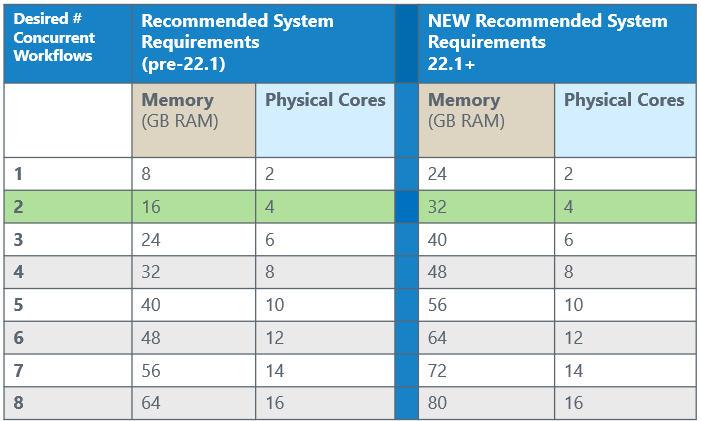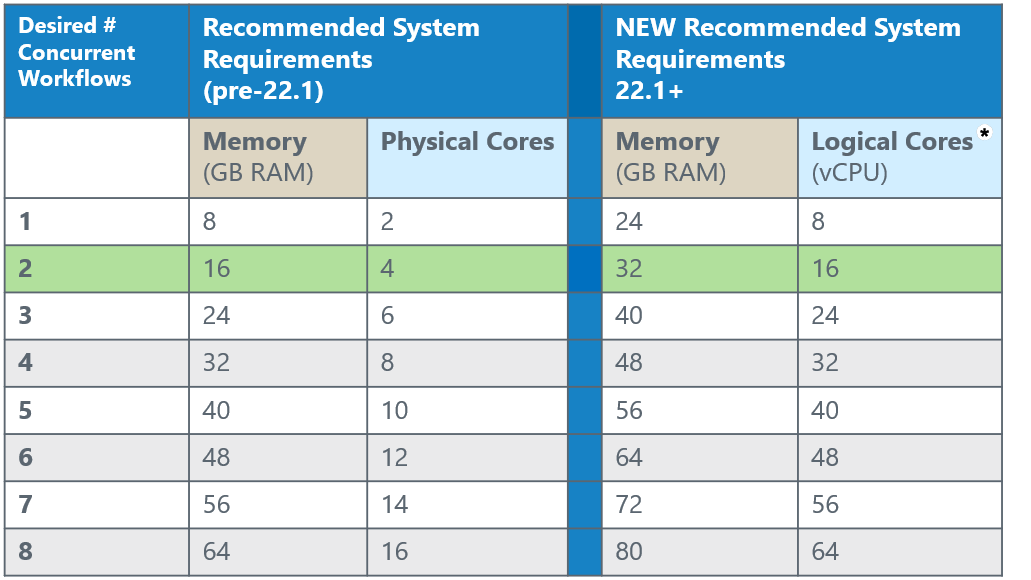Server est pris en charge sur des ordinateurs de bureau, des serveurs autonomes et des environnements de machines virtuelles dotés de la configuration minimale requise suivante.
Configuration minimale requise par nœud Server | Recommandations pour les environnements de production par nœud Server (environnement à plusieurs nœuds)* | |
|---|---|---|
UC | Intel ou AMD x86-64 (64 bits) | Intel Xeon E, Xeon W, AMD EPYC 7xx2, AMD Threadripper ou version ultérieure |
Nombre de cœurs de processeur** | 4 cœurs (8 cœurs logiques) par nœud Exemple d'environnement :
| + de 8 cœurs (+ de 16 cœurs logiques) par nœud Exemple d'environnement :
|
Mémoire système | 16 Go | + de 32 Go |
Taille de disque minimale recommandée | 500 Go | SSD de + de 1 To |
*Les déploiements de production en entreprise varient selon le cas d'usage. Pour obtenir de l'aide sur l'évaluation des besoins de configuration du matériel, contactez votre représentant Alteryx. Pour en savoir plus, consultez ce livre blanc et notre page Configuration.
**Ce tableau part du principe qu'un cœur physique correspond à 2 cœurs logiques. Pour plus d'informations, consultez notre page dédiée aux définitions des licences.
Nous avons divisé nos recommandations en deux catégories : Configuration matérielle minimale requise et Matériel recommandé pour des performances optimales.
Server minimum hardware requirements are defined as the minimum hardware needed to run a stable installation of Alteryx Server. If you don't meet minimum requirements, it puts you at risk of having poor performance and/or having the service shut itself down on any node where the engine runs.
The following minimum hardware requirements are recommended for desired number of concurrent workflows:

Note that the green highlighted line is the minimum recommended configuration. The line showing information for 1 concurrent workflow is helpful for you to understand how much you need to increase resources to add 1 additional job to the existing configuration.
Server optimal performance hardware recommendations are defined as the sweet spot in hardware where Server can complete workflows as efficiently as possible. This is useful to eliminate congestion on busy systems.
The following hardware recommendations are recommended for optimal performance:

*Logical cores are either vCPUs or logical cores within a physical core. The standardization to refer to logical cores is a way of comparing consistently across both physical on-prem servers and virtual servers in the cloud.
Fin de la prise en charge de Windows Server 2012
À partir de la version 2023.2 de Server, Alteryx ne prend plus en charge Windows Server 2012, car il a atteint la fin de la prise en charge par Microsoft. Consultez la page Le support de Windows Server 2012 et 2012 R2 prend fin pour en savoir plus.
Microsoft Windows Server 2016 64 bits ou version ultérieure
Microsoft .NET Framework 4.6 ou version ultérieure
Installez les outils prédictifs pour exécuter les workflows qui utilisent les outils prédictifs sur Server.
Mode FIPS désactivé.
Important
The Persistence or Database Layer can be implemented using either a user-managed MongoDB or MSSQL database. Alteryx provides a default MongoDB with its Server products, located on the Controller node and referred to as Embedded MongoDB.
While Embedded MongoDB is often sufficient, a properly implemented user-managed database can offer performance and reliability improvements. However, a user-managed database requires the organization to invest significantly in skills and resources to implement, maintain, and support it.
With Embedded MongoDB, Alteryx provides a pre-tested, reliable database configuration with full visibility and support. In contrast, a user-managed database requires the user to handle all aspects of database setup, management, configuration, and, importantly, troubleshooting.
Alteryx can advise on user-managed databases that are compatible with Alteryx Server. However, the organization is responsible for managing the database, including having an available and knowledgeable administrator to troubleshoot any issues. Alteryx has no access to the logs or files of user-managed databases, which are essential for diagnosing issues in Embedded MongoDB.
Additionally, it is the responsibility of the user-managed database to be tuned and optimized to meet the performance needs of the Alteryx application.
MongoDB
Server configuration requires MongoDB. For more information about MongoDB versions, go to MongoDB Schema Reference.
Embedded MongoDB:
If you are upgrading from a version prior to 2021.3.6, you must start with a version of Server that uses MongoDB 4.0 before you upgrade to 2021.3.6 version or higher. Versions of Server that use embedded MongoDB include 2019.3 through 2021.3.5.
For embedded MongoDB, the host, username, and password are automatically generated.
User-Managed MongoDB:
Server supports MongoDB versions 4.2, 4.4, 5.0, 6.0, and 7.0 for user-managed instances.
For user-managed MongoDB, specify the host, username, and password from your MongoDB instance.
If you were previously using SQLite for Alteryx Scheduler, jobs have to be manually re-scheduled when switching to MongoDB.
For more information, visit the MongoDB Schema Reference help page.
SQL DB
Currently, the only officially supported version of SQL is MSSQL Server 2019 and 2022, as well as Amazon RDS for SQL Server. Your SQL database administrator can determine the appropriate MSSQL Server edition and sizing for your database, whether Standard or Enterprise.
You must have an MSSQL Server instance hosted and network accessible from your Alteryx Server controllers.
We recommend using a separate SQL database for AlteryxGallery / AlteryxService to access.
The SQL DB access user needs full control (admin level ) for any SQL DBs Alteryx Server will be using.
The version of Server you are upgrading to 2024.1 from must be 2022.1+ GA or 2022.3+ FIPS.
If you use built-in authentication and you upgrade from a version lower than 2022.1, you need to reset your password due to security improvements. If you didn't reset your password in version 2022.1, you need to have SMTP enabled. This is so users can reset their password via the forgot password functionality or so that an admin can trigger password resets for all users via the UI or API. For more information on how to reset your Server password after an upgrade to 2022.1, visit the Reset a User's Server Password help page.
You must install SQL Server drivers. For more information, go to Mongo to SQL Migration Guide.
Optional: Access to SQL Server Management Studio.
This allows you to view/access database data manually, so you can verify and validate the state of your data without having to go into your Server.
For more information on how to migrate from MongoDB to SQL DB, go to Mongo to SQL Migration Guide.
Il s'agit des ports par défaut utilisés par Server. Si nécessaire, vous pouvez personnaliser les ports de Server.
Publique | |
|---|---|
80 | AlteryxService, AlteryxServerHost sans SSL/TLS (webserver) et AlteryxAuthHost (service d'authentification) |
443 | AlteryxServerHost (webserver) et AlteryxAuthHost (service d'authentification) avec SSL/TLS |
27018 | MongoDB intégré |
Bouclage uniquement | |
|---|---|
5562 | AlteryxMetrics |
8700-8799 | Python pour Analyses |
Droits d'administrateur | Pour installer Server, l'accès administrateur au système d'exploitation du serveur hôte ou l'accès physique au matériel du serveur est requis. |
Accès en lecture à Active Directory | Accès en lecture à Active Directory est requis si vous prévoyez d'utiliser l'authentification Windows intégrée. Consultez la page d'aide Authentification Server pour en savoir plus sur les options d'authentification. |
Accès au système de licences Alteryx | Assurez-vous que l'ordinateur peut contacter le domaine Web whitelist.alteryx.com utilisé par le système de licences Alteryx. |
Accès au partage de fichiers | Autorisations de lecture et d'écriture pour le partage de fichiers. |
Utilisateur administrateur Alteryx | L'administrateur de Server peut gérer les utilisateurs et les workflows. Un administrateur de Server par défaut est spécifié lors de la configuration de l'authentification pour accéder à Server. Consultez la page d'aide Authentification Server pour en savoir plus sur la spécification de l'administrateur de Server par défaut. |
Exécuter en tant qu'utilisateur | Dans les environnements de serveurs renforcés par des stratégies d'autorisations restrictives, vous devrez peut-être activer les autorisations de sécurité Windows Server pour la prise en charge des informations d'identification Exécuter en tant que. Configuration des autorisations Exécuter en tant qu'utilisateur requises. |
Adresse de base : l'adresse de base est l'URL utilisée par les utilisateurs pour accéder à Server. L'URL par défaut est http://localhost/gallery/, que vous pouvez utiliser pour exécuter Server localement.
Serveur SMTP : les informations d'hôte SMTP sont nécessaires pour les notifications de Server par e-mail. Les notifications et les validations de compte sont gérées par e-mail.